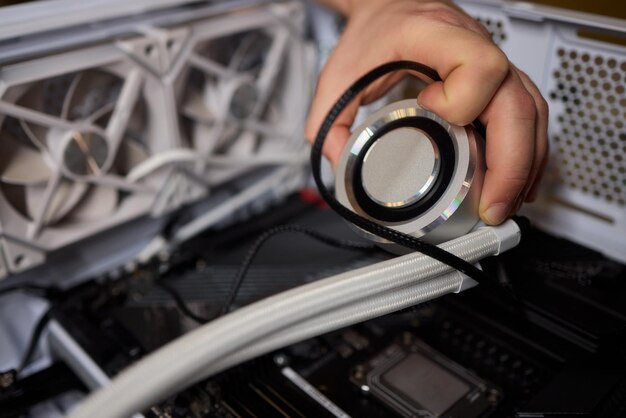Replacing Your LG Refrigerator Water Filter: Everything You Need to Know
Maintaining your LG refrigerator is essential for ensuring it functions efficiently and keeps your food fresh. A key component of this maintenance is the regular replacement of the water filter. Many users may overlook this simple task, but doing so can significantly affect the quality of your water and ice cubes—and consequently, your health and taste preferences. Whether you're changing the filter for the first time or looking to brush up on best practices, this guide will walk you through the process with ease and confidence.
🤔 Why Change Your LG Refrigerator Water Filter?
Changing your water filter is crucial for a variety of reasons:
- Improved Water Quality: Over time, filters become clogged with impurities, reducing their effectiveness. A new filter ensures cleaner, better-tasting water.
- Health Benefits: By removing contaminants and pollutants, regular filter changes contribute to better health.
- Efficiency: Keeping the filter updated can prevent undue stress on your refrigerator, enhancing overall performance and lifespan.
- Avoiding Odors: Stale filters can introduce unwanted flavors or odors to your water or ice.
Keeping track of when to change your filter can be tricky, but most models require a change every six months or after filtering approximately 200 gallons.
🔍 Identifying Your LG Water Filter Type
Before you start, identify which type of filter fits your LG refrigerator model. LG offers different filter designs, so refer to your refrigerator’s manual for the correct match. Here’s a quick look at some common types:
- Twist-On Filters: Often located inside the refrigerator, these are released with a simple twist.
- Push-In Filters: Typically found in the grille or inside the refrigerator, they can be removed by pressing a button or releasing a latch.
How to Find the Right Replacement
- Check Your Manual: Your refrigerator’s manual should list compatible water filters.
- Model Number: Find your refrigerator's model number, usually on a sticker inside the fridge, to purchase the correct filter.
- LG Website: The official LG website provides detailed guidance on filter options based on refrigerator models.
🛠️ Step-by-Step Process to Change Your Water Filter
Step 1: Preparation
- Gather Supplies: You'll need the new filter, a towel to catch drips, and maybe a small bowl.
- Turn Off the Power: It's crucial to unplug the refrigerator to ensure safety. Water and electricity do not mix well.
Step 2: Remove the Old Filter
- Twist-On Filter: Open your refrigerator door and locate the filter, usually near the top. Twist the filter counterclockwise to remove it.
- Push-In Filter: If the filter is inside the refrigerator, you might need to press a button near the filter to release it. If it's in the grille, open the grille and pull the filter out.
Step 3: Install the New Filter
- Twist-On Filter: Insert the new filter and twist clockwise until it locks into place.
- Push-In Filter: Insert the new filter, ensuring the unlock symbol aligns with the arrow on the slot. Push in until it clicks into place.
Step 4: Flush the Filter
It’s important to flush the new filter to remove any carbon residue or loose particles.
- Run Water: Allow water to flow through the dispenser, discarding the first couple of gallons.
- Check for Leaks: Observe the filter area for any water leaks as you run water through it.
Step 5: Reset the Change Filter Indicator
Most modern LG refrigerators have an indicator to alert you when it’s time to change the filter. After replacing it, don’t forget to reset the indicator:
- Hold the Reset Button: Press and hold the reset button for 3-5 seconds. Usually, it’s on the dispenser panel.
📝 FAQs and Troubleshooting Tips
What if I can’t remove the old filter?
- Check for Blockages: Ensure nothing is obstructing the filter, such as foreign objects or ice buildup.
- Warm Water: Carefully apply a bit of warm water to the area to melt any ice, being cautious not to wet electrical components.
Why is water flow low even with a new filter?
- Air Trapped: Sometimes air gets trapped during installation. Repeating the flushing process can help.
- Check Fitting: Ensure the filter is properly fitted and securely installed.
How do I dispose of the old filter?
Filters can often be recycled, depending on local regulations. Some stores that sell filters may offer recycling services.
💡 Summary: Quick Tips for Changing Your LG Refrigerator Water Filter
Here's a quick recap to ensure your filter replacement goes smoothly:
- 📆 Replace Regularly: Every six months or when water taste declines.
- 🔄 Use the Right Filter: Match the model number with a compatible replacement.
- 🛡️ Safety First: Unplug the refrigerator before starting.
- 💧 Flush After Installation: Run water to ensure quality.
- ⏰ Reset Indicators: Hold down the reset button after replacement.
By staying proactive with your filter maintenance, you ensure not only better-tasting water but also the efficiency and longevity of your appliance. Feel empowered to tackle this straightforward task, knowing that you’re contributing to a healthier home environment. Remember, keeping your refrigerator’s water filter fresh is a small yet impactful step towards daily water enjoyment and appliance care!
